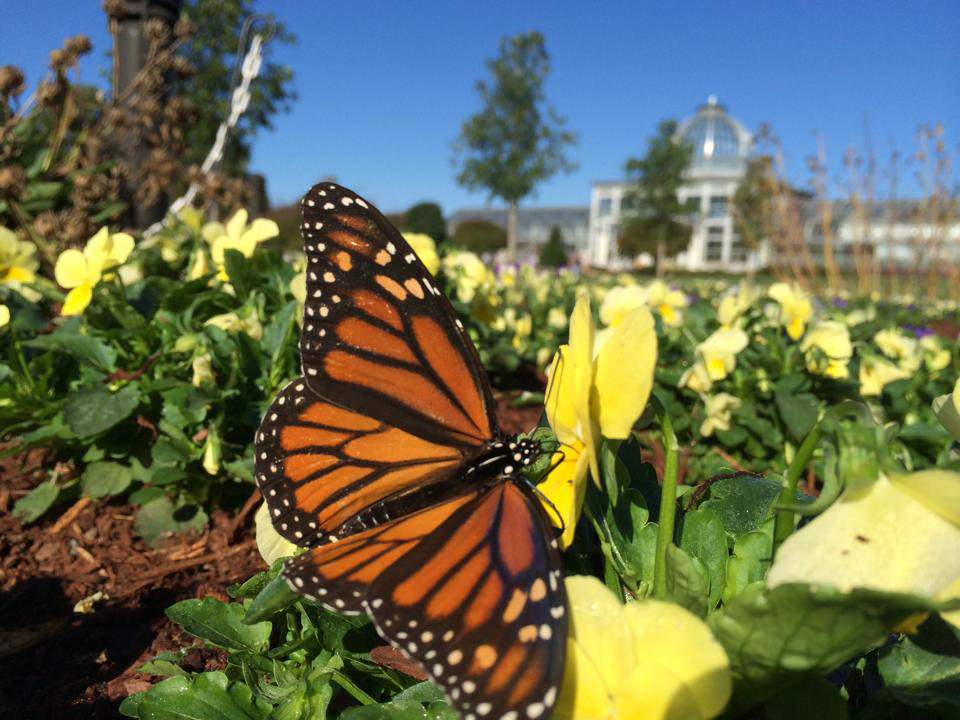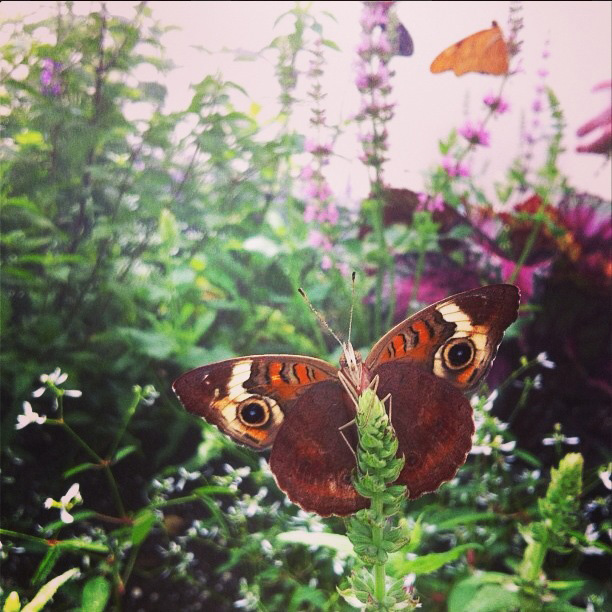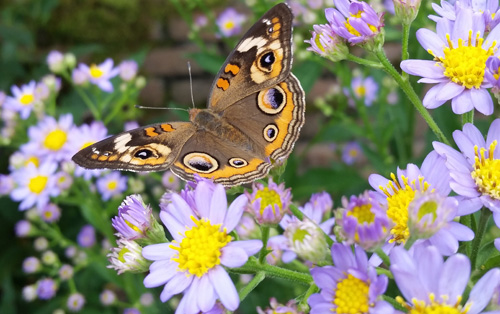Is the Monarch Butterfly Disappearing? Are Butterflies Less Common Now?
Recently, many visitors have been asking if we’ve noticed a dramatic decline in monarch butterfly sightings and butterfly sightings in general.
“I have a pollinator garden and have seen no more than one butterfly aside from the cabbage butterflies. Wondering about your experiences,” a visitor explained.
We actually get a lot of questions about this topic. Some of the most frequent comments I see are: “I have nectar plants in my yard, but I’m not seeing any butterflies,” or “I used to have butterflies, but now I don’t—what happened?” Many people seem to wonder where their butterflies have gone, or why they simply aren’t seeing any since planting a new garden.

A monarch butterfly visiting the Central Garden in late fall. The Conservatory is in the background.
If you’re not seeing butterflies in your yard, despite having ample nectar, there are five potential problems, some of which you can do something about, and some of which you can’t. It sounds as though this individual may have already taken care of some of these issues, but for the benefit of others, I’ll talk about the most common issues and what you can do about them.
- Lack of Host Plants
The first problem you may be encountering is a lack of host plants. When I say “host plant,” what I mean is: a plant that the larvae of the butterflies like (or need) to eat. While nectar plants can be occasionally enticing to a passing adult butterfly or moth, they alone are not enough to encourage a thriving population of butterflies in your yard. In order to have the most successful butterfly garden, including for the monarch butterfly, you need both nectar plants and host plants. Most butterflies are quite specific in what their larvae will eat; many will only lay eggs on a single particular plant or family of plants. This makes it especially important for them to visit areas that have these plants, and you’ll see a drastic increase in butterfly populations in your yard if your garden contains them. A list of several good host plants for Virginia butterflies includes everything from milkweed for the monarch butterfly to maypops (Passiflora incarnata) and mayapple (Podophyllum peltata) for the variegated fritillary to Cherry, tulip tree, lilac, willow, ash, sweet-bay for the Eastern tiger swallowtail butterfly.
Sometimes people plant things that they don’t realize are host plants, such as Angelonia (used as a host by buckeye butterflies) or violas (used by some fritillary butterflies), and when they change out their plantings year to year they may remove plants that butterflies were breeding on. Many important host plants are also considered “weeds,” such as violets, plantain, clover, dandelions, and thistles—so efforts to control these plants in your area could also be harming the butterfly populations. - Pesticides
The second problem–and this is a big one–is pesticides. Any time you (or your neighbors) spray for mosquitoes, you’re actually spraying to kill just about every insect that lives in your yard. These mosquito spray services kill almost all insects, including beneficial ones, and yes–they do a great job of killing butterflies.
Unfortunately, mosquito sprays aren’t actually doing all that much to control mosquitoes either. These toxins target only adult mosquitoes, which doesn’t really do a lot to manage the population in general. They don’t touch the larvae, which live exclusively in water.
The best way to control mosquitoes is to avoid having standing water around. Though sometimes there isn’t much you can do about this, and in these cases, you can place mosquito dunks in water sources to control the larvae. The dunks contain a bacteria that is specially tuned to attack mosquito larvae, and little else. This makes them, thankfully, butterfly-safe. But unfortunately, much of the time, it isn’t the butterfly-lover that’s responsible for killing off the butterflies in the area–it’s their neighbor that wants a bug-free lawn. A wonderful way to help out butterflies (and the entire ecosystem) is to reach out to your local community and try to (politely) persuade folks not to spray. Many times, they don’t realize the damage this spraying has on the ecosystem. - Weather
The third reason you might not be seeing as many butterflies as expected is the weather. In different years, there are different conditions that affect overwintering butterflies. If the conditions are optimal in the spring, you’ll see a big population boost. If they’re not, you’ll see fewer. ideal conditions for butterflies include a spring that warms up gradually, and doesn’t have a period of heat followed by a cooldown (hard freezes after periods of warm weather are particularly bad for overwintering insects), a winter/spring that’s not abnormally wet or dry and a winter that doesn’t stay too warm—abnormally high temperatures can make overwintering bugs come out too early and subsequently not have anything to eat.
Junonia coenia; a native buckeye butterfly feasting in nectar. Image by Jonah Holland
- Population Decline
The fourth reason, and probably the one that gets the most to the heart of this question, is that there are simply fewer butterflies (and indeed insects in general) than there used to be. Fewer butterflies mean fewer offspring too. Habitat loss, wide use of pesticides, and other human factors have combined to drastically lower the insect population. A New York Times article describes this global decline as “The Insect Apocalypse,” and it describes a worrying trend across multiple nations. Insects, including butterflies, are–put simply–disappearing.
The numbers recorded at the monarch overwintering site in Mexico seem to confirm this, as they have been steadily declining for years. Last year, there were only 2.83 hectares covered with monarch butterflies, as opposed to 10 hectares, which is around where the average number was in the ’90s. Of course, there are always ups and downs in this data set due to various factors, but overall, the decline is unmistakable. - Habitat Loss
The fifth reason that we aren’t seeing as many moths, butterflies and other insects is habitat loss in general, and specifically the loss of leaf litter. In neighborhoods, many people want a “clean” and debris-free look so they bag all of their leaves, and cut back their dead plant material like stems and reeds. Moths pupate in leaf litter, and fireflies’ larvae live and hunt in leaf litter. Some butterflies overwinter as caterpillars in old plant material too. Fritillaries and red-spotted purples, for example, overwinter in the “dead” parts of their host plant. So, if you love butterflies, fireflies and moths, don’t clear your leaf litter!
On a personal note, I have indeed noticed a decline in butterfly populations over the years. Some of this is due to weather–this year’s spring was not great for the butterflies, but overall there are definitely fewer. I remember days when you couldn’t drive down the road without feeling guilty for hitting a tiger swallowtail. Now I hardly see any on my morning or evening commute.
Here at the Garden, we are doing our best to combat this trend of fewer butterflies by providing habitats for our native pollinators. If you’d like to learn more about how to do the same, you can sign up for the “Grow Natives” lecture series, hosted by Plant Virginia Natives partnership, Lewis Ginter Botanical Garden and Blue Ridge PRISM.
The Grow Natives webinar series is also funded, in part, by the Virginia Coastal Zone Management Program through grants from the NOAA Office for Coastal Management to the Virginia Department of Environmental Quality.
Here are some of the key speakers and dates:
September 1, 2021, 6:30 – 8 p.m.
The Humane Gardener: Nurturing Habitat for Wildlife
Nancy Lawson, The Humane Gardener
September 14, 2021, 6:30 – 8 p.m.
Topic title to come
Peggy Singlemann, Maymont Foundation
September 28, 2021, 6:30 – 8 p.m.
It’s Easy to Reach High – Plant Native Trees
Jim McGlone, Virginia Department of Forestry
October 12, 2021, 6:30 – 8 p.m.
Selecting Native Plants for Fall and Winter Interest and Ecology
Kim Eierman
October 26, 2021, 6:30 – 8 p.m.
Common Invasive Plants in Virginia: Identification, Control and Native Alternatives
Elizabeth Mizell, Blue Ridge PRISM
November 9, 2021, 6:30 – 8 p.m.
How to Make Your Yard a Winter Beacon to Birds and Other Wildlife
Carol Heiser
Each session will be recorded and available to be viewed for 1 week following the live event.
